The story of Chiatura’s Pioneer Palace including a short history, how to get there and a 2022 update
2022 UPDATE
We originally visited the former Pioneer Palace in Chiatura in the summer of 2018. Back then, as we mention below, there was some construction work taking place nearby. We revisited the location in February 2022. The construction work was still ongoing but much closer to the pioneer palace than in 2018. There were mounds of earth and rubble all around and a man operating a digger on the site told us we weren’t allowed to pass through to the building. As a result, we were unable to get close the second time around. But, according to this article on the website of Chiatura Municipality, the development of a recreation area in the vicinity of the palace started around the middle of June 2021. A merry-go-round has been installed and, what’s more, a photo on Google Maps dated June 2022 shows a recently erected Ferris wheel.
This begs the question, what is to become of the ruins of the pioneer palace? Thinking positively, the palace could either be rejuvenated along the lines outlined later in this article, or perhaps the ruins will be sealed off and become the backdrop to the recently created recreational space. One of the newly-built cable car stations is called ‘Sanatorium’ and this is nearby so either of these options could become a reality.
As this post goes on to explain, the building is also listed by the National Agency for Cultural Heritage Preservation as a protected architectural monument. But, the press release on the Chiatura Municipality website also states;
“It should be noted that the building of the Palace of Pioneers is a monument of cultural heritage, and therefore, the rehabilitation of the building cannot be considered within the framework of the mentioned project.”.
It’s not 100% clear what this statement implies. On the flip side of the coin, the only new information we have about the fate of the pioneer palace comes from a comment from a reader of this blog, who recently visited the place and was informed via workman that it would soon be demolished to make way for something else.
With no concrete updated information online, either way, all that can be done is to wait and see what is to become of the former Pioneer Palace in Chiatura.
If you visit, please let us know of any developments so we can update the post – thank you.
Chiatura is a small mining town in western Georgia where large deposits of manganese were discovered in 1879 (*). Up until around the end of 2018/early 2019, one of the primary reasons to come here as a visitor was to see the network of ageing cable cars and associated stations which were constructed in the mid-1950s to transport the miners up and down the steep ravines to their place of work.
(*) At their pre-World War I height (circa 1913), the mines at Chiatura were producing half the world’s output of manganese ore. These days, the mines are still operational, although the level of production is less significant.
Taking a ride in one of these Soviet relics, which have been dubbed, among other names, ‘flying coffins’, was certainly an ‘experience’ but, as we mention in this more detailed post about things to do in Chiatura, the old cable car network no longer functions and has been replaced with a modern French-designed-and-constructed aerial tramway system.
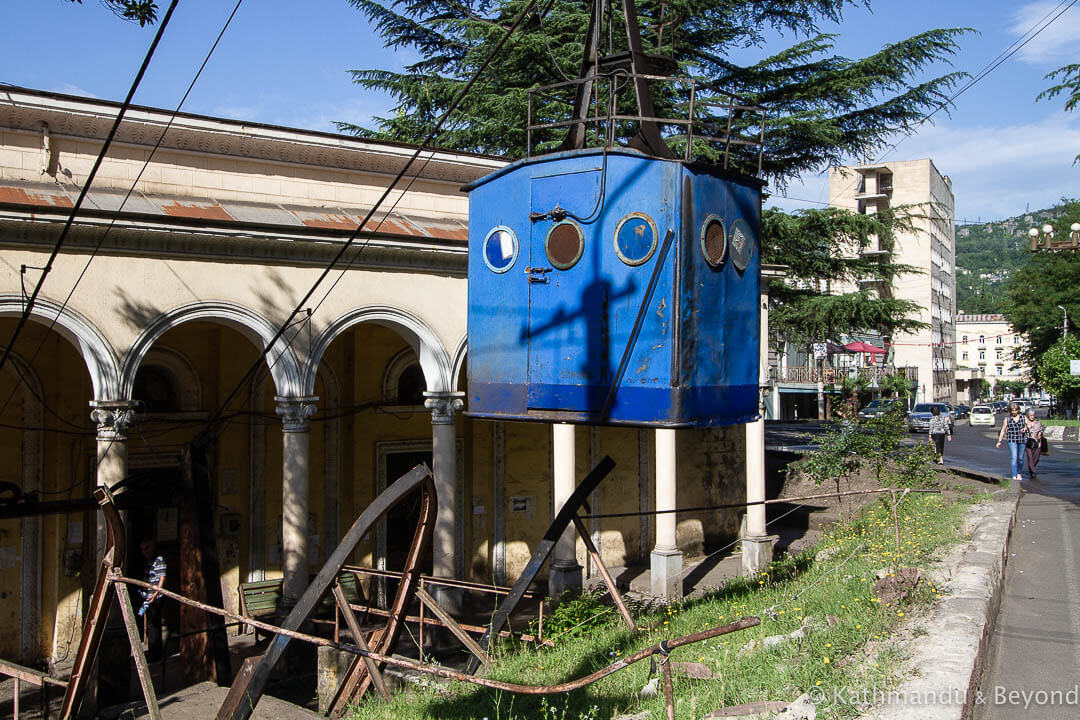
The good news, however, is that even if it is no longer possible to get your adrenaline pumping by taking a journey in one of these precarious-looking iron boxes, there are a number of other good reasons to justify visiting Chiatura.
One of these reasons is the town’s now-abandoned palace for young pioneers. As I explained in this post about the Pioneer Palace in Dnipro, Ukraine, the pioneer movement was an organisation set up for children in the Soviet Union that was modelled on the Boy Scout movement. Similar to the Scouts, the primary focus of the Young Pioneers was physical and mental well-being but, unlike its counterpart in the West, the Pioneer movement also put emphasis on political education.
Pioneer Palaces, the Soviet equivalent of summer camps, were established in conjunction with the organisation and a number of them were housed in opulent buildings that once belonged to the Russian Empire’s upper class. In this instance, the building and its grounds weren’t attached to an aristocratic family before being turned over to budding communists. Rather, it was built for purpose in 1960 and, even though the style officially only lasted until 1955, what’s left of the property displays strong elements of Stalinist Empire style architecture, such as the colonnades, both inside and out, and the sweeping staircases.
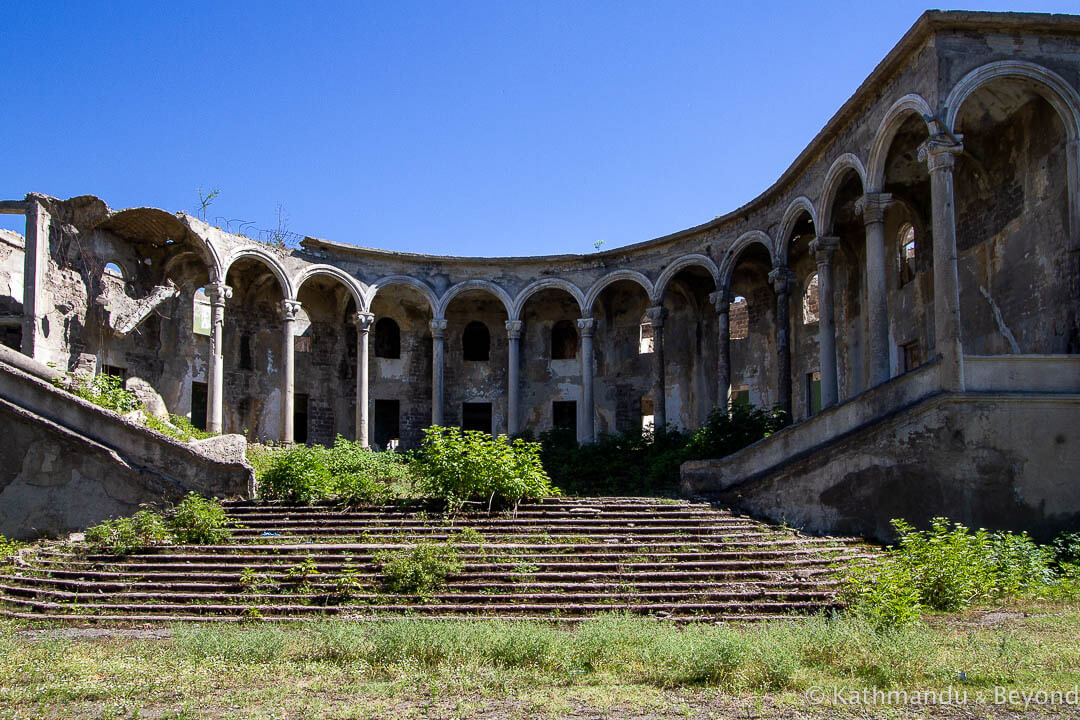
For nigh on three decades, the palace in Chiatura, which sits on a plateau 200 metres above the town, was an integral part of the local community. Many cultural activities, such as dance, chess and photography, were taught there to the young pioneers and the park in which the building was located was frequented by the town’s residents for recreational purposes, regardless of age.
The demise of the Pioneer Palace in Chiatura is linked with an earthquake that struck Georgia in April 1991 (Chiatura was one of the worse-hit areas) and the dissolution of the USSR, which began in earnest just a few months after the tremor struck (*). During the political and socio-economic transformation that followed the breakdown of the Soviet Union, activities at the palace initially dwindled and then ceased altogether and the building and its grounds eventually fell into a state of ruin. No doubt, the place was also looted and vandalised around the same time.
(*) The collapse of the USSR, in general, had a significant (negative) impact on the Young Pioneer movement throughout the Union.
The building and the land belong to the Municipality of Chiatura and the property is protected as an architectural monument by the National Agency for Cultural Heritage Preservation.
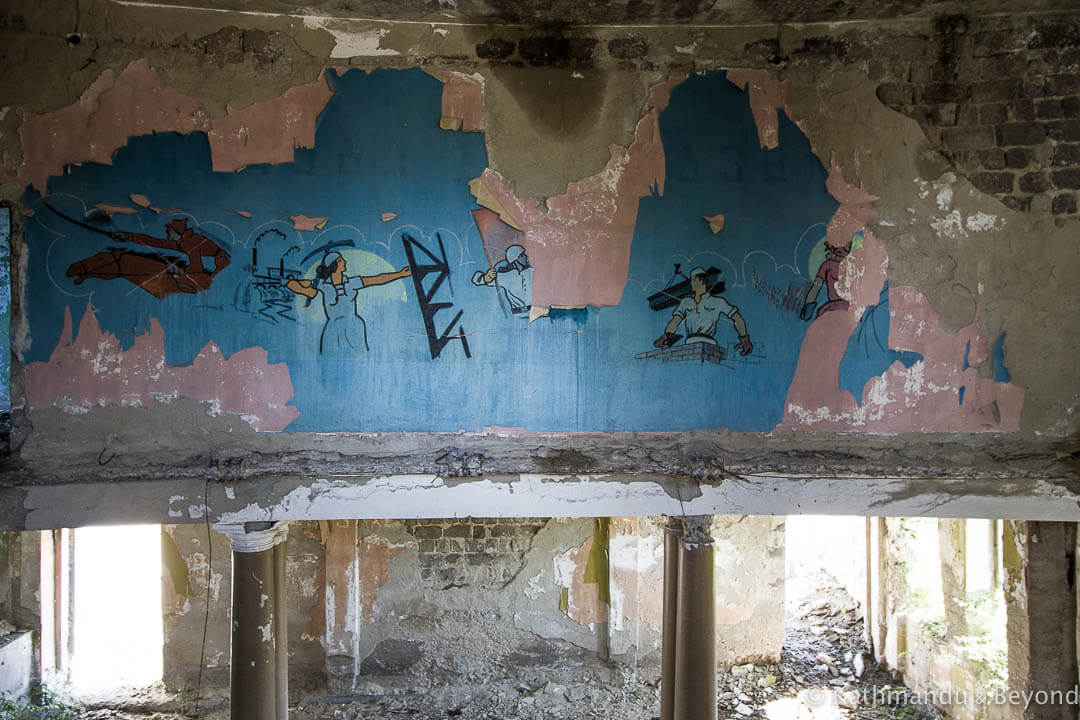
I know all the above information because I found this long and detailed feasibility study published by an organisation called COMUS. Standing for Community-led Urban Strategies in Historic Towns, COMUS is a joint European Union and Council of Europe initiative that was set up in 2015 to establish community-led projects in five countries: Armenia, Azerbaijan, Georgia, Moldova and Ukraine. The time frame for the scheme was two years (until 2017) and during that period the €650,000 budget was used to support nine culturally-significant towns across the five countries.
One of the locations chosen as part of the project was Chiatura and more specifically, the rehabilitation of the former Pioneer Palace and its surrounding grounds. In brief, the objective of the project was to revive the palace and turn it into a cultural/educational centre aimed at children through to young adults aged between 6 and 23 years old.
As mentioned, we first visited Chiatura in 2018 and although we did notice signs of construction/development work taking place nearby we didn’t know about the above enterprise at the time and so didn’t pay special attention to what was going on. What I will say, however, and this is clear from the enclosed photos, is that there was absolutely no indication that any kind of work had been carried out on the Pioneer Palace itself.
I’m assuming, therefore, that in this instance the COMUS plans for the building did not materialise. The report was, after all, labelled as a feasibility study and when you take into account the enormity of the restoration work required on such a structurally unsound building, the (rather short) two-year timeframe and the fact that the €650,000 budget is for nine such schemes, not just this one, it would not have been too surprising an outcome.
On the other hand, and taking a positive approach, perhaps reconstruction work on the palace did take place post our visit and the building is back to its former glory or at least getting there? But, I cannot find any online evidence (articles, photos etc.) to suggest this is the case and so I suspect this is a highly unlikely scenario and that the Pioneer Palace remains in a terribly-neglected state and looks like it is going to collapse at any moment.
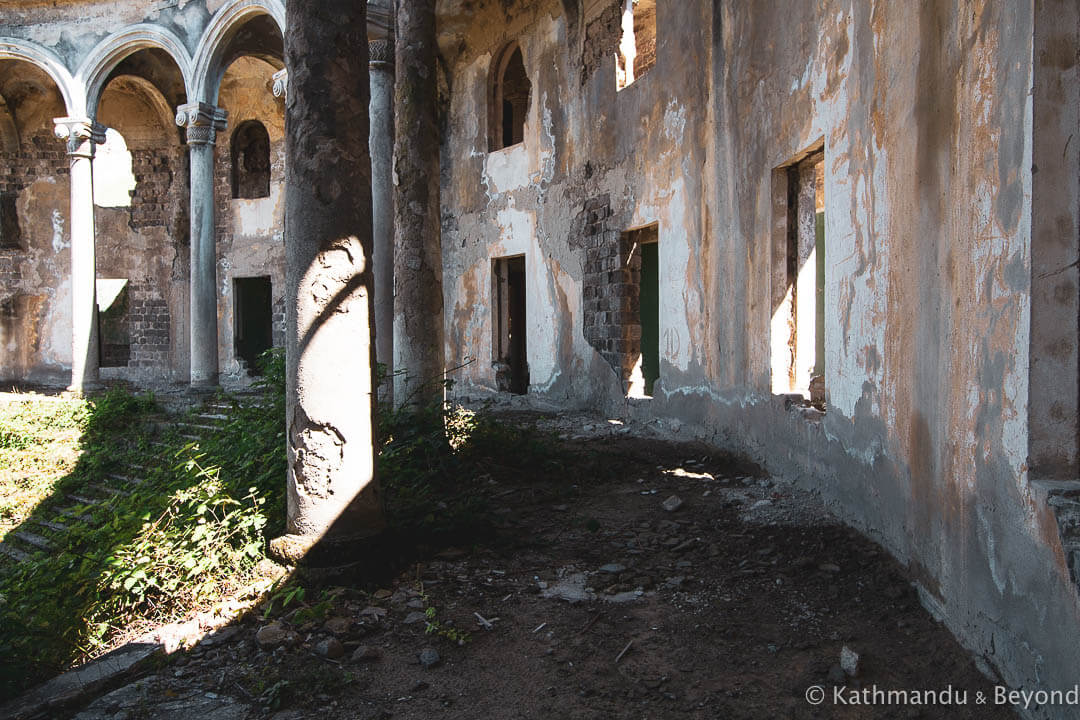
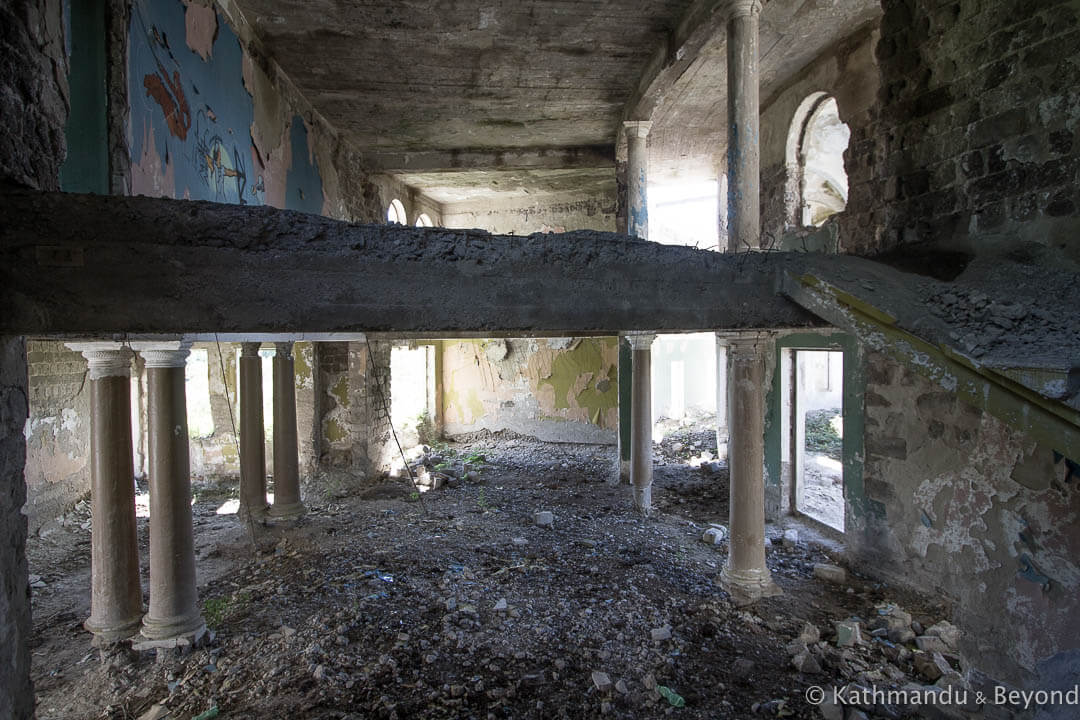
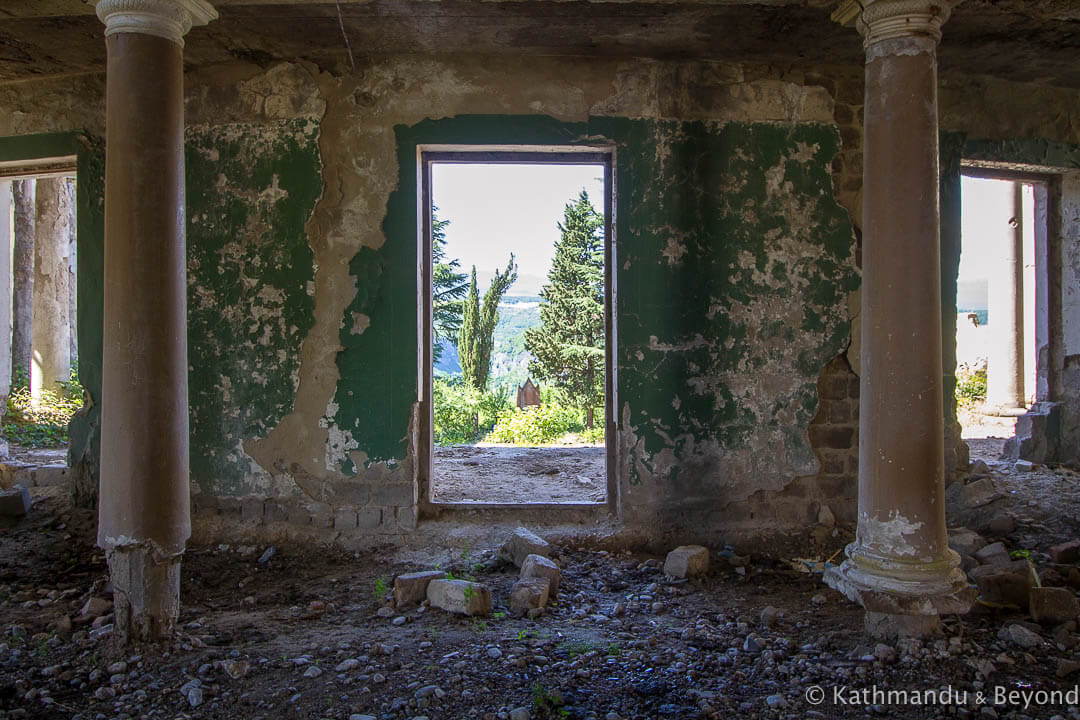
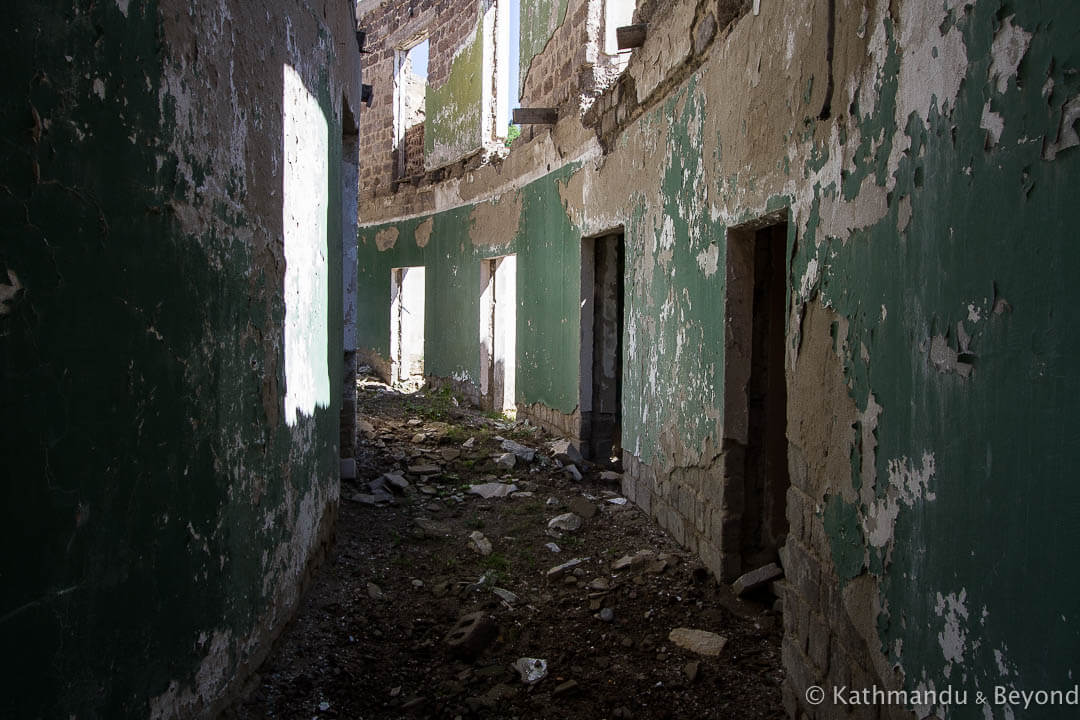
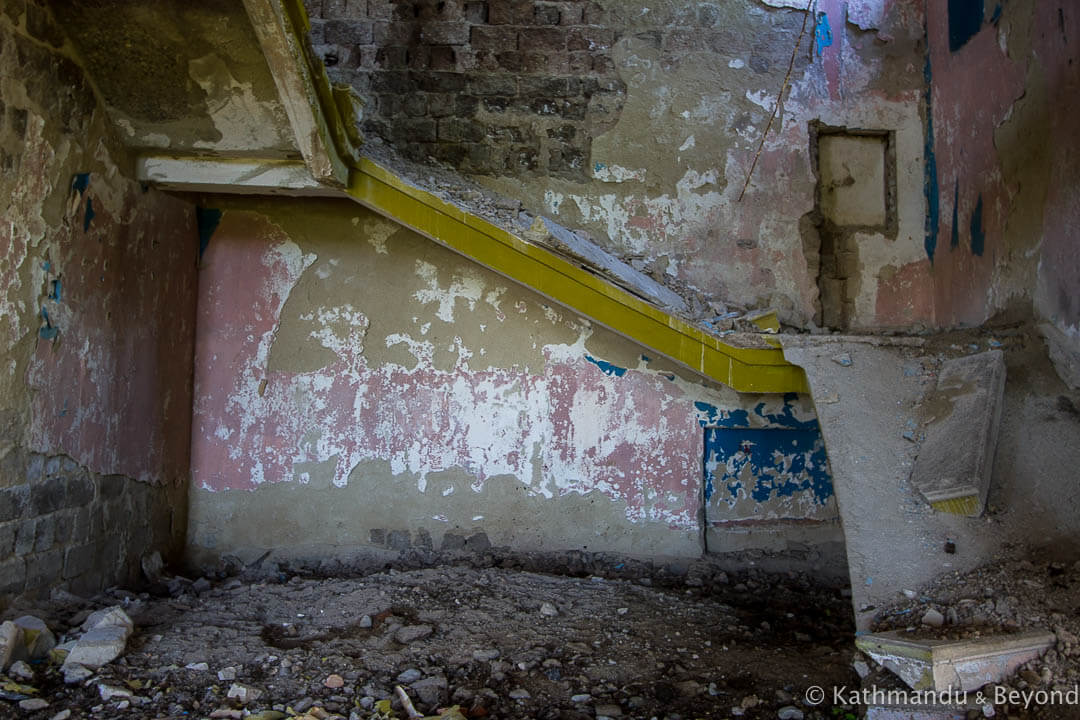
Edit: As I was about to finish this post, I found this November 2019 Georgian news article that talks about three projects in Chiatura that the youth of the town are participating in. One of the ideas involves the Pioneer Palace and creating a “space of the future”. Partly, rather than fully restoring the palace, the idea is to make the place multifunctional, including an open-air stage, sports fields, a museum about the history of mining, and a conference hall. The article even mentions relocating the town’s wedding palace (registry office) to the same spot. The other two parts of the project involve the development of art/literature space in one of the now-defunct cable car stations and the creation of a tourist development centre/Tourist Information Centre.
Although it sounds ambitious, according to the feature, the project is supported by the United Nations Development Program and I, for one, have my fingers crossed that the plan comes to fruition in some shape or form. Many of Chiatura’s residents struggle financially and, what’s more, the town has seen a drastic decline in its population over the years with the younger generation, in particular, leaving to find work and better/more exciting opportunities elsewhere. Chiatura is one of the most unique destinations we have visited in Georgia and if some of the locals are on board with getting these initiatives off the ground, this, along with hopefully getting the original cable cars running once more (which is also being proposed), could potentially lead to a significant increase in tourism which, in turn, will mean more wealth, an increase in local employment and, ultimately, less migration.
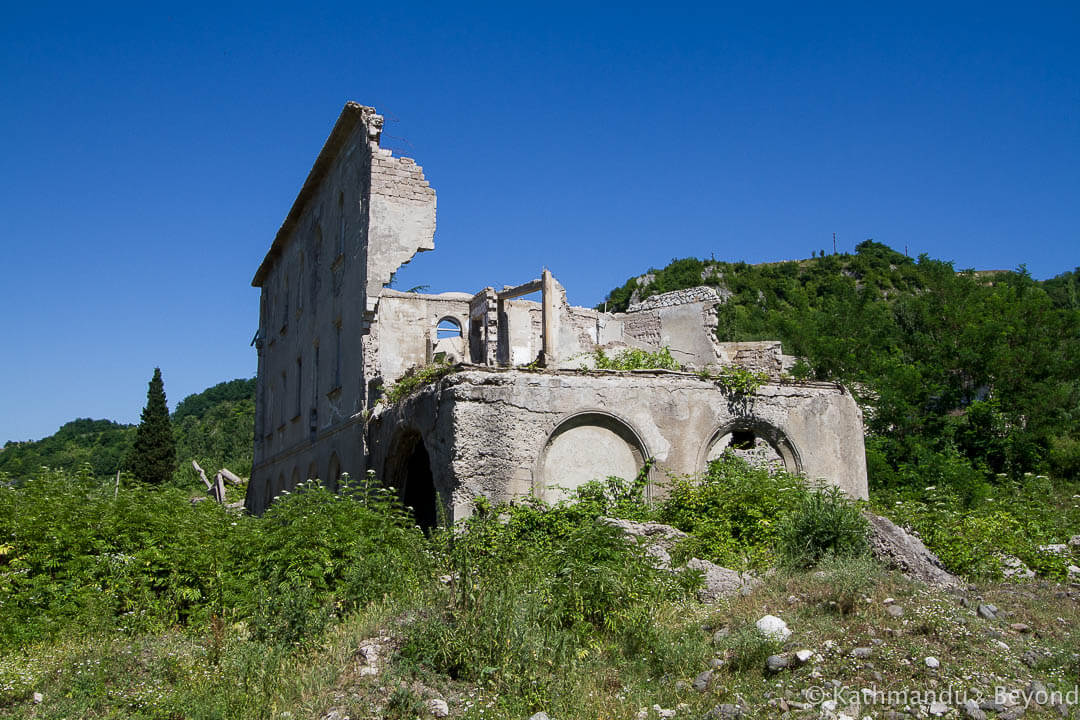
Finding the Pioneer Palace in Chiatura
The Pioneer Palace is now marked on Google Maps but when we were trying to locate the place back in the summer of 2018, it wasn’t listed on any map and we had trouble pinpointing its exact location. We asked the two men who picked us up at the Zestafoni junction and gave us a lift to Chiatura if they knew of its whereabouts but they didn’t. We also went into the town hall and asked around and even showed a photo we had to the owner of the kebab shop where we shamefully had our lunch (there aren’t a lot of food options in Chiatura!) but there was nothing doing.
On the verge of giving up, for the time being, we were having another scour of Google Maps in the reception area of the hotel we had just checked into. Via her daughter, who spoke English, a sweet babushka (granny) seated in the corner of the room asked us what we were looking for. We showed her our photo (which was a bit of a struggle given her eyesight wasn’t great!) and, 15 minutes later, we were in the back of a taxi and on our way. It transpired that the, also elderly, taxi driver who took us there was well aware of the place and had been there many times himself as a budding young pioneer. He came with us on our exploration and, via Google Translate, told us that the palace was once a glorious building and that he had many happy memories of his time there.
The moral of the story: if you want to find somewhere abandoned and connected to Soviet times in the former USSR, ask a babushka or a dedushka, the male equivalent.
The exact coordinates of the former Pioneer Palace in Chiatura are 42.281488, 43.283983.
Getting to the Pioneer Palace in Chiatura
Unless you want to, it is no longer necessary to take a taxi to the former pioneer palace in Chiatura. The easiest, and cheapest way nowadays is to head to the Central Cable Car Station and take the cable up to the upper station ‘Sanatorium’. From there it is a 150-metres/2-minute walk to the Pioneer Palace.
READ MORE BLOGS ABOUT ABANDONED PLACES
READ MORE BLOG POSTS ABOUT GEORGIA
IF YOU ENJOYED OUR ACCOUNT OF CHIATURA’S PIONEER PALACE, PLEASE SHARE IT…
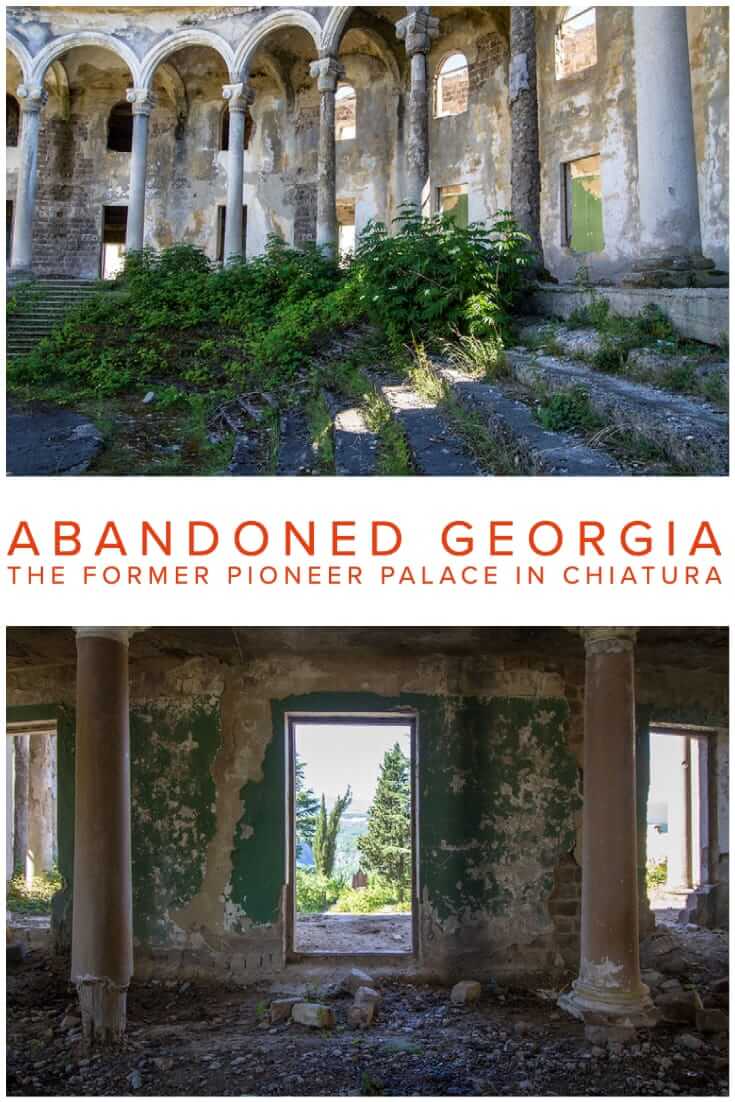
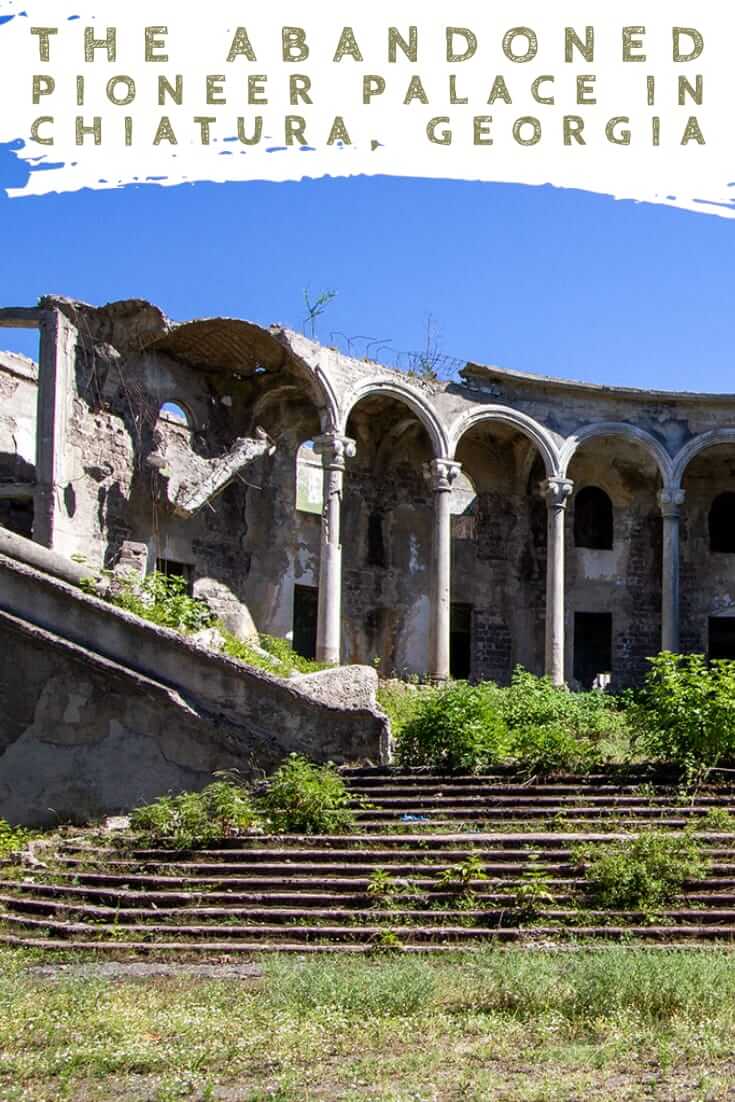
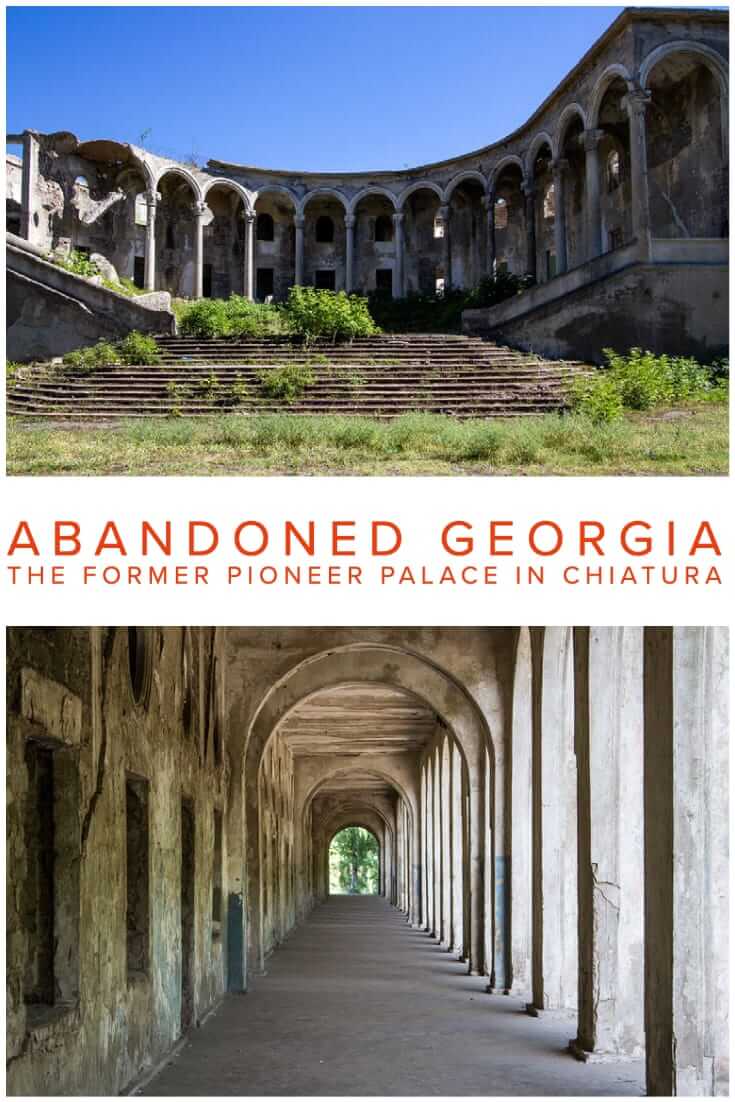

Wow! Even in ruins it’s beautiful. I would like to visit this place one day.
As you say, it is lovely, even in ruins! Hopefully it will be restored as per the plan at some point in the future.
i was just there last month. there were workers saying it will be destroyed in two months to make space for something else 🙁
Thanks for the update. Sad news but not surprising to hear, unfortunately. I’ll keep an eye on the situation and update the post accordingly.
Hi! I visited today and have an update, a new park has been built in front of the former Pioneer Palace. This is basically a paved area with a small Ferris Wheel and a merry go round. The Pioneer Palace has bee left intact and a big fence built around it. It’s a bit odd, like it’s in a zoo! You could get round fence to get into the Palace but there were quite a few people there so we didn’t feel like we could try. Either way for now it’s still there just harder to visit! I can share some pics if you’d like
Hi Joe, Thank you for taking the time to write to us regarding the former Pioneer Palace. I will update the post based on your comments. If you are able to send a couple of photos to our email address ([email protected]) it would be appreciated as it would help me visualise how the area looks now. Cheers, Mark
great pix, these are super nice place, even now it’s ruins, but u can imagine how beautiful it was, thanks for the pictures showing another aspect of the world.
Thank you! Glad you enjoyed the post. It was a fascinating place to revisit; currently it’s under renovation so will be interesting to see it again when complete.